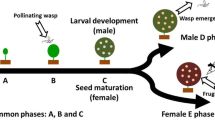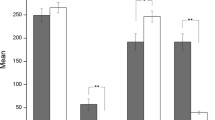Abstract
Ficus species (figs) and their species-specific pollinator wasps are involved in an intimate mutualism in which wasps lay eggs in some ovaries of the closed inflorescences (syconia), and mature, inseminated offspring carry pollen from mature syconia to fertilize receptive inflorescences. In monoecious species, each syconium produces seeds and wasps. In functionally dioecious fig species, making up approximately half the figs worldwide, male and female functions are separated; hermaphrodite (functionally male) trees produce wasps and pollen only, while female trees produce seeds only. This sexual separation allows selection to act independently on the reproductive biology of each sex. Examining sexual specialization in a tight mutualism allows us to determine aspects of the mutualism that are flexible and those that are canalized. In this study, we quantified the phenology of two species of dioecious figs, F. exasperata and F. hispida, for 2 years by following the fates of several thousand syconia over time. In studying each of these species in a dry and a wet site in south India, we tested specific predictions of how dioecious figs might optimize sexual function. On female trees of both species, more inflorescences matured during the wet (monsoon) season than in any other season; this fruiting period enabled seeds to be produced during the season most suitable for germination. In F. exasperata, functionally male trees released most wasps from mature syconia in the dry season, during peak production of receptive female syconia, and thus maximized successful pollination. In F. hispida, “male” trees produced more syconia in the dry and monsoon seasons than in the post-monsoon season. In both species, male and female trees abscised more unpollinated, young inflorescences than pollinated inflorescences, but abscission appeared to be more likely due to resource- rather than pollinator- limitation. The phenology of F. exasperata requires that male inflorescences wait in receptive phase for scarce pollinators to arrive. As expected, male inflorescences of this species had a longer receptive phase than female inflorescences. In F. hispida, where pollinators are rarely scarce, duration of receptive phase was the same for both sexes. Duration of developing phase was longer in female syconia of both species than in male syconia, most likely because they need a longer period of investment in a fleshy fruit. Variation in developing phase of female syconia in one species (F. exasperata) was also greater than that in male syconia, and enabled female trees to sample a variety of germination environments in time. The strong sexual differences in both fig species support the hypothesis that selection for sexual specialization has strongly influenced the reproductive biology of these species.
Similar content being viewed by others
Author information
Authors and Affiliations
Additional information
Received: 28 May 1997 / Accepted: 2 February 1998
Rights and permissions
About this article
Cite this article
Patel, A., McKey, D. Sexual specialization in two tropical dioecious figs. Oecologia 115, 391–400 (1998). https://doi.org/10.1007/s004420050533
Issue Date:
DOI: https://doi.org/10.1007/s004420050533




